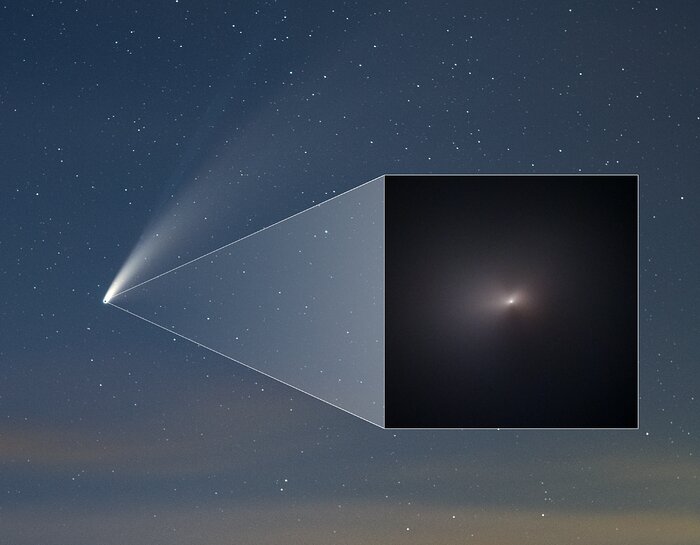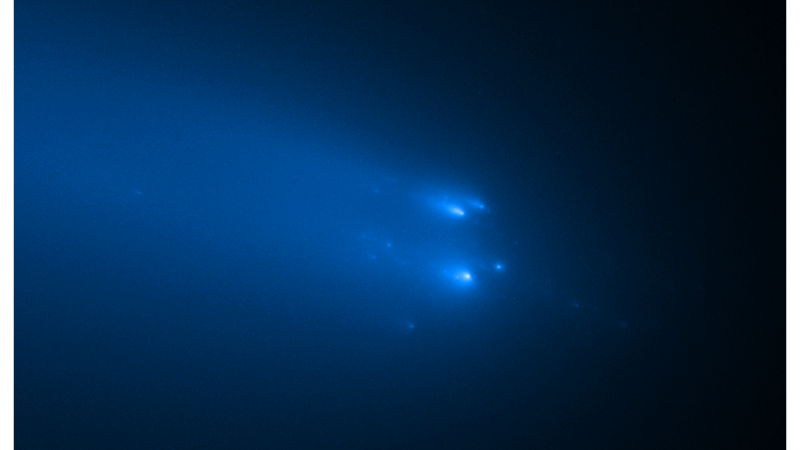Time is running out to catch a glimpse of the comet NEOWISE. The comet — the brightest object to grace the skies over the Northern Hemisphere in 25 years — will soon disappear from view. At least as far as the naked eye is concerned. Fortunately, the Hubble Space Telescope is on hand to capture stunning images of the comet — discovered on March 27th by NASA’s Wide-field Infrared Survey Explorer (WISE) space telescope during its mission to search for near-Earth objects.

The image taken by Hubble on 8th August — which represents the closest ever taken of the comet since it first lit up the sky — shows NEOWISE as it sweeps past the Sun. This is the first time that astronomers have managed to capture such a bright object as it passes our star.
Hubble snapped the object as it rapidly makes its way out of the solar system, with it not scheduled to return for 6,800 years. The comet caused a stir amongst amateur star watchers and the general public as it was visible with the naked eye under the right conditions.
“Nothing captures the imagination better than actually seeing its tails stretching into the sky in person,” Qicheng Zhang, a graduate student studying planetary science at Caltech, Pasadena, CA, who has been heavily involved in the study of NEOWISE. “The comet last came around about 4,500 years ago. This was around when the Egyptian pyramids were being built.”
“My research area covers comets and their evolution under solar heating,” Zhang explains to ZME Science. “I also like to keep track of potentially bright comets to actually see in the sky, which included this particular comet.”

The image shows NEOWISE’s halo of glowing gas and dust illuminated by light from the Sun surrounding the icy nucleus of the comet, too small at little more than 4.8km across to be fully resolved by the telescope. In contrast, the dust halo that surrounds the comet’s heart is too large to be fully resolved by the space telescope, with its diameter measuring an estimated 18,000 km.
Zhang points out that as NEOWISE moves past the Sun, there is a chance we could still glimpse its icy core: “As the comet recedes from the Sun, the dust with clear and reveal the solid nucleus currently buried within, providing an opportunity to directly observe the source of all the activity that made the comet impressive last month.”
Let’s Stick Together: Why NEOWISE Survived and ATLAS Didn’t
Previous attempts to capture other bright comets as they pass the Sun have failed because these objects have disintegrated as they passed too close to the star. This break-up is driven by both the incredible heat of the Sun causing the icy heart of the comets to fragment, and the powerful gravitational influence of our star further pulling the comets apart.
The most striking example of this came shortly after the discovery of NEOWISE, with the observation of the fragmentation of the comet ATLAS in April this year. The collapse of this comet — believed at the time to offer our best look at such an icy body — in 30 separate pieces was also caught by Hubble.

Unlike comet ATLAS, itself only discovered in December 2019, comet NEOWISE somehow survived its close passage to the Sun–with its solid, icy nucleus able to withstand the blistering heat of the star– enabling Hubble to capture the comet in an intact state.
As the latest image of NEOWISE shows, however, it is not going to escape its encounter with the Sun completely unscathed. Jets can clearly be seen blasting out in opposite directions from the poles of the comet’s icy nucleus. These jets represent material being sublimated–turning straight from a solid to a gas skipping a liquid stage–beneath the surface of the comet. This ultimately results in cones of gas and dust erupting from the comet, broadening out as the move away from the main body, forming an almost fan-like shape.
Far from being just a stunning image of a comet as it passes through the inner solar system, the Hubble images stand to teach astronomers much about NEOWISE and about comets in general.
“It’s a fairly large comet that approached closer to the Sun than the vast majority of comets of its size do,” Zhangs says. “These factors contributed to its high brightness and also made it a good candidate to see how solar heating alters comets, as the effects are theoretically amplified by its close approach to the Sun.
“That information is useful for interpreting observed characteristics of other comets that don’t approach as close to the Sun, and thus where the changes are more gradual and might not be directly observable.”
In particular, the colour of the comet’s dust halo, and the way it changes as NEOWISE moves away from the Sun, gives researchers a hint as to the effect of heat on such materials. This could, in-turn, help better determine the properties of the dust and gas that form what is known as the ‘coma’ around a comet.
“We took images to show the colour and polarization of the dust released by the comet, to get a sense of what it looks like before it’s broken down by sunlight,” says Zhang. “That analysis is ongoing–and will take a while to do properly–but as the published images show, we’ve caught at least a couple of jets carrying dust out from the rotating nucleus.”
The information contained in the Hubble data will become clearer as researchers delve deeper into it. But, the investigation of NEOWISE’s cometary counterparts will benefit from future telescope technological breakthroughs. This will include spotting comets much more quickly and thus, further out from the Sun.
“When this comet was discovered by the NEOWISE mission, it was only 3 months from its close approach to the Sun and had already begun ramping up activity,” Zhang says. “More sensitive surveys, like the upcoming Legacy Survey of Space and Time (LSST) at the Rubin Observatory, will allow us to find such comets much earlier before they become active, enabling us to track them throughout their apparition from beginning to end.
“This will facilitate a more precise comparison of what changes the comets undergo during their solar encounter.”
The next step in Zhang’s research, however, will be comparing the qualities of comet NEOWISE to other such objects, particularly a recent interstellar visitor to our solar system: “This is one of three comets I have observed or have planned to observe in this manner, the others being the interstellar comet 2I/Borisov and the distant solar system comet C/2017 K2 (PANSTARRS),” the researcher concludes. “My team of collaborators and I will be evaluating all three comets to see how their differences in present location and formation/dynamical history translate into differences in physical properties.”






